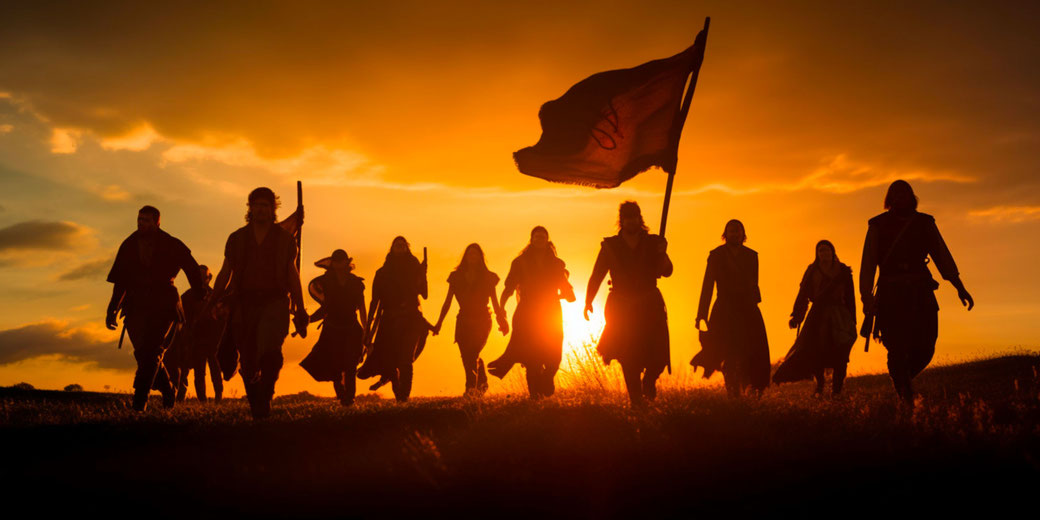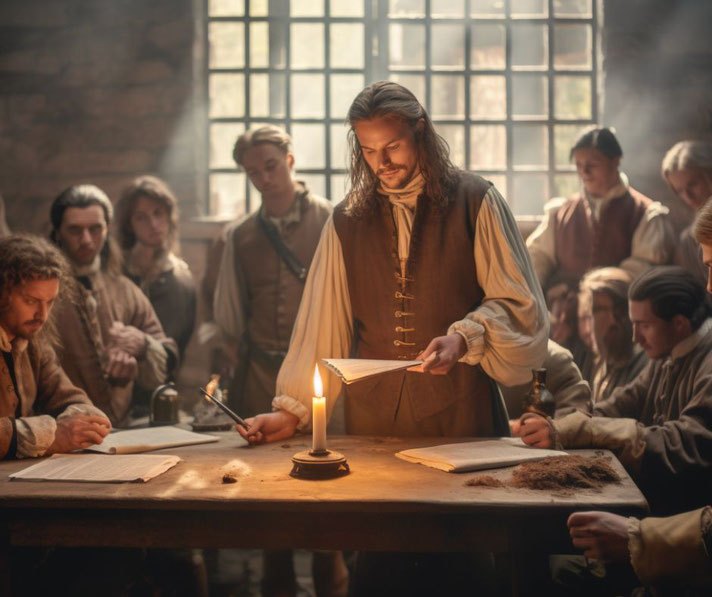The Pilgrimage of Grace: England's forgotten uprising against Henry VIII

The Pilgrimage of Grace is one of the most significant yet often overlooked uprisings in English history. Occurring in the tumultuous year of 1536, this popular revolt created a national crisis that shook the very foundations of Henry VIII's reign.
Sparked by a series of grievances ranging from the Dissolution of the Monasteries to the imposition of new taxes and the broader English Reformation, the Pilgrimage of Grace saw tens of thousands of commoners and nobles alike rise up in an unprecedented show of civil disobedience.
The chaos created by Henry VIII
The early 16th century was a period of seismic shifts in England, both religiously and politically.
Henry VIII's reign had been marked by his contentious break with the Roman Catholic Church, a move instigated by his desire to annul his marriage to Catherine of Aragon and marry Anne Boleyn.
The Act of Supremacy in 1534 declared Henry the Supreme Head of the Church of England, effectively severing ties with Rome and setting the stage for the English Reformation.
This had profound social and economic implications. The Dissolution of the Monasteries, initiated in 1536, was a particularly disruptive policy.
Monasteries were not just places of worship; they were also centers of education, healthcare, and charity.
Their dissolution led to the loss of social services and the seizure of economic assets, affecting communities across the nation.
Adding fuel to the fire were the economic hardships of the time. Inflation, unemployment, and new taxes levied to fund Henry's military campaigns created a climate of discontent.
The common people felt increasingly alienated by a government that seemed to prioritize royal whims over public welfare.
The nobility, too, were uneasy, as the religious reforms threatened their traditional way of life and the social order upon which their power was based.
The North of England, where the Pilgrimage of Grace would eventually erupt, was particularly affected.
It was a region deeply attached to the Catholic faith, and the dissolution of local monasteries was seen as a direct attack on its identity and traditions.
All these factors—religious, economic, and social—converged to create a powder keg of discontent, waiting for a spark to ignite.
Who led the Pilgrimage of Grace?
At the forefront was Robert Aske, a lawyer from the North of England who emerged as the charismatic leader of the rebellion.
Aske was not just a man of legal expertise; he was also deeply religious and a compelling orator.
His leadership gave the disparate grievances of the rebels a unified voice and direction, encapsulated in the Oath of Pontefract, which laid out the demands of the Pilgrims.
Aske's ability to galvanize a wide range of society, from commoners to nobles, made him a formidable opponent to the Tudor government.

The role of Thomas Howard, the 3rd Duke of Norfolk, should also not be underestimated.
Tasked with suppressing the rebellion, Norfolk was a seasoned military leader and a shrewd political operator.
His strategy of divide and conquer, coupled with promises of pardons and negotiations, played a crucial role in the eventual suppression of the Pilgrimage.
Norfolk's actions during the rebellion were instrumental in its failure but also indicative of the government's realization that it could not simply crush the revolt without addressing some of the underlying grievances.
The uprising begins...
The initial spark of the Pilgrimage of Grace ignited in October 1536, in the northern county of Yorkshire.
The region was a stronghold of Catholic sentiment, and the news of the Dissolution of the Monasteries had been met with widespread outrage.
The immediate trigger was an incident in Louth, Lincolnshire, where a local official was attacked while trying to collect a tax that was part of Henry VIII's new economic measures.
This seemingly isolated event quickly escalated, as word spread and local grievances coalesced into a more organized form of resistance.
Within days, thousands had joined the cause, and what had started as a local protest had transformed into a full-blown uprising.
Under the guidance of Aske, the movement took on a more structured form, adopting the name "The Pilgrimage of Grace" to reflect its religious undertones.
Aske led the rebels in a march to York, one of the most significant cities in the North, capturing it without resistance.
The speed with which the city fell demonstrated not just the strength of the rebellion but also the depth of popular discontent.
The rebels then formalized their demands in the Oath of Pontefract, which called for the restoration of the monasteries, the dismissal of ministers like Thomas Cromwell, and the return to a more traditional form of Catholic worship.

The movement continued to gain momentum, drawing support from various segments of society, including some members of the nobility.
The rebels laid siege to key fortifications like Hull and Scarborough, although with varying degrees of success.
Despite the setbacks, the sheer size of the uprising—estimated to involve upwards of 30,000 people at its peak—made it impossible for the Tudor government to ignore.
Henry VIII's initial response was one of alarm, and the task of suppressing the rebellion was given to Thomas Howard, the 3rd Duke of Norfolk, a seasoned military leader.
Military tensions with the protestors
The Tudor government's response was initially cautious but became more resolute as the gravity of the situation became clear.
Thomas Howard, the 3rd Duke of Norfolk's strategy was one of divide and conquer.
He sought to exploit divisions within the rebel ranks, offering pardons and engaging in negotiations to peel away support from the core group of insurgents.
At the same time, he prepared for military action, gathering forces and fortifying key positions.
His approach was pragmatic, aimed at avoiding a full-scale military confrontation that could be both bloody and politically risky.
As the rebellion wore on, it became clear that the government's strategy was having an effect.
The promise of pardons and the prospect of negotiations led some rebels to lay down their arms, sapping the movement of its initial momentum.
The failure to capture key fortifications also weighed heavily on the rebels, as it limited their ability to control important routes and resources.
While there were skirmishes and confrontations, the rebellion never escalated into the kind of large-scale military engagement that could decisively tip the balance in favor of one side or the other.
This was in part a testament to the caution of both parties: the rebels were wary of provoking a brutal crackdown, while the government was mindful of the political repercussions of using excessive force against its own citizens.
The drama of the Doncaster Conference
Held in the town of Doncaster in late October 1536, a conference was held in an attempt to find a peaceful resolution to the uprising.
Thomas Howard represented the Tudor government, while Robert Aske led the delegation for the rebels.
The very fact that such a meeting took place was an acknowledgment by the government of the seriousness of the situation; ignoring or brutally suppressing the rebellion was no longer an option.
Norfolk arrived at the conference with a dual mandate: to quell the rebellion but also to avoid a full-scale military confrontation that could be both costly and politically damaging.
He came armed with promises of a general pardon for the rebels and a commitment to convey their grievances to King Henry VIII.
Aske and his fellow leaders, for their part, arrived with the demands formalized in the Oath of Pontefract, which included the restoration of the monasteries and the removal of ministers like Thomas Cromwell.
The conference was thus a delicate dance, a balancing act between the rebels' demands for significant reforms and the government's desire to maintain control without making sweeping concessions.
The outcome of the Doncaster Conference was a temporary truce rather than a definitive resolution.
Norfolk managed to convince Aske and the other rebel leaders to disband their forces in return for a pardon and a promise that their grievances would be heard by the King.
This was a calculated risk for the rebels, who had to weigh the benefits of a peaceful resolution against the potential costs of continued rebellion.
The decision to accept Norfolk's terms was met with a mix of relief and skepticism among the rebel ranks; while some saw it as a pragmatic step toward achieving their goals, others viewed it as a betrayal of the movement's original aims.

Arrests and suppression
Following the temporary truce agreed upon at the Doncaster Conference, it became increasingly clear that the government had little intention of meeting the rebels' demands in full.
While the conference had succeeded in dispersing the rebel forces temporarily, it had not resolved the underlying grievances that had fueled the uprising.
The promises of addressing the rebels' concerns were largely unmet, and the general pardon offered was not as comprehensive as many had hoped.
This led to a sense of betrayal among the rebels, and by early 1537, renewed uprisings began to erupt in various parts of the North.
The government's response this time was swift and decisive. Thomas Howard's tone now changed.
The government was no longer in a mood for negotiation; it was a time for action.
Rebel leaders were arrested, and some, including Robert Aske, were executed.
The trials were often quick, and the punishments severe, aimed at sending a clear message to anyone who might consider defying the Tudor regime.
The suppression was not just a military operation but also a legal and political one, aimed at reasserting the authority of the state and the sanctity of Henry VIII's religious reforms.
The suppression had a chilling effect, effectively quashing any hopes of renewing the rebellion.
However, it also left a legacy of bitterness and mistrust that would linger for years.
The heavy-handed tactics employed by the government, including the execution of Aske and other leaders, were seen by many as a betrayal, not just of the rebels but of the very principles of justice and governance.
The suppression of the Pilgrimage of Grace marked the end of one of the most significant popular uprisings in English history, but it also raised questions about the limits of dissent and the costs of maintaining order.
What do you need help with?
Download ready-to-use digital learning resources
Copyright © History Skills 2014-2024.
Contact via email
With the exception of links to external sites, some historical sources and extracts from specific publications, all content on this website is copyrighted by History Skills. This content may not be copied, republished or redistributed without written permission from the website creator. Please use the Contact page to obtain relevant permission.





